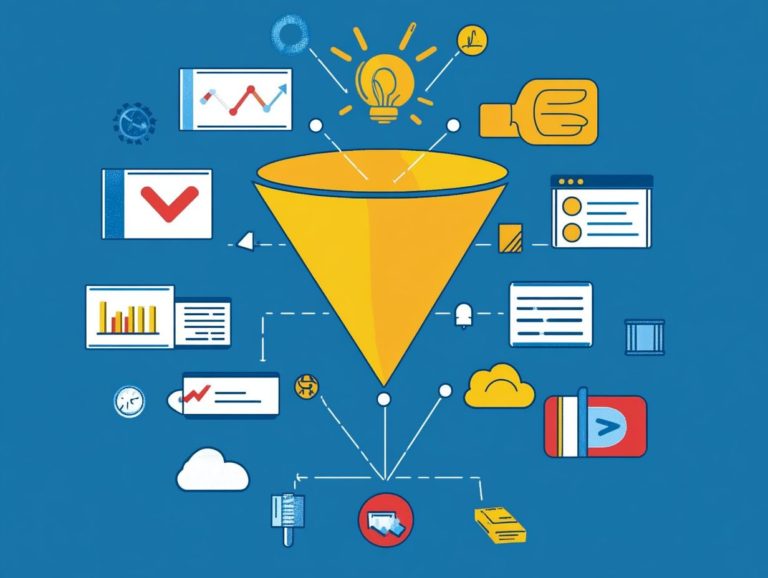5 Metrics to Monitor for B2C Lead Generation
Let's Set Up Your Lead Generation Strategy
Fill out the form below, and our team will get in touch with you to create a tailored solution for your business.
In the fast-paced realm of B2C marketing, mastering the art of generating and nurturing leads is essential for achieving success.
Let s explore five key metrics that can supercharge your lead generation: website traffic, conversion rates, cost per lead, time to conversion, and customer lifetime value. These metrics will empower you to effectively assess your lead generation efforts.
You ll discover the significance of B2C lead generation, explore the various types available, and tackle the common challenges that arise. You will also find helpful strategies for improvement.
And let s not forget about the emerging trends that are set to shape the future of this vital process. Act now to elevate your B2C lead generation game to new heights!
Contents
- Key Takeaways:
- 1. Website Traffic
- 2. Conversion Rates
- 3. Cost Per Lead
- Let's Set Up Your Lead Generation Strategy
- 4. Time to Conversion
- 5. Customer Lifetime Value
- What Is B2C Lead Generation and Why Is It Important?
- Let's Set Up Your Lead Generation Strategy
- Let's Set Up Your Lead Generation Strategy
- Frequently Asked Questions
- What are the 5 metrics that should be monitored for B2C lead generation?
- Why is website traffic an important metric for B2C lead generation?
- How is conversion rate related to B2C lead generation?
- What is the significance of cost per lead in B2C lead generation?
- How does lead-to-customer conversion rate impact B2C lead generation?
- Why should businesses pay attention to customer lifetime value in B2C lead generation?
- Let's Set Up Your Lead Generation Strategy
Key Takeaways:

- Monitor website traffic to understand the effectiveness of your lead generation efforts and make necessary adjustments.
- Keep an eye on conversion rates to measure the percentage of website visitors who turn into leads.
- Calculate cost per lead to evaluate the efficiency and ROI of your lead generation strategies.
1. Website Traffic
Website traffic is essential for any successful marketing strategy. It drives lead generation and customer acquisition in today s digital world.
A robust volume of website traffic signifies a thriving stream of potential customers engaging with your content, products, or services. This ultimately influences key performance indicators like conversion rates and customer satisfaction.
To optimize this vital flow, tap into a variety of traffic sources. Consider organic search, which pulls in users through expertly optimized content; social media platforms, where community engagement thrives; and paid campaigns that deliver targeted outreach to your ideal audience.
Understanding user engagement metrics such as bounce rates (the percentage of visitors who leave your site after viewing only one page) and session durations (how long visitors stay on your site) is crucial for evaluating how well your website retains visitors and guides them through the sales funnel, enhancing their customer journey.
Leveraging tools like Semrush or Salesforce enables you to track these metrics with ease. These insights help you adjust your strategy and boost overall performance.
2. Conversion Rates
Conversion rates are crucial metrics that reflect the effectiveness of your sales process. They indicate how well your marketing efforts transform website traffic into potential customers and, ultimately, into sales qualified opportunities.
Several factors influence these rates, particularly the strategic placement of effective calls-to-action (CTAs), the overall design of your website, and the user experience it delivers. For example, a well-crafted landing page featuring a clear and compelling CTA can lead to a significant increase in conversions.
Companies like HubSpot have expertly employed A/B testing to fine-tune their marketing strategies. Even minor adjustments like altering button colors or repositioning elements can substantially impact engagement metrics and improve conversion rates.
Crafting personalized experiences is essential for building trust and enhancing the likelihood of conversion. Therefore, understanding and implementing strategies that resonate with your target audience is paramount.
3. Cost Per Lead
Cost per lead (CPL) is a vital metric that reveals the efficiency of your customer acquisition strategies. It shows the total marketing spend required to generate a single lead entering your sales funnel.
Let's Set Up Your Lead Generation Strategy
Fill out the form below, and our team will get in touch with you to create a tailored solution for your business.
Grasping this figure enables you to evaluate the effectiveness of your campaigns and allocate your budget with greater precision. A well-calculated CPL uncovers potential areas for improvement and establishes a crucial link between customer acquisition costs and lead scores.
By optimizing these interconnected metrics, you can identify weaknesses in your marketing efforts, enhance lead quality, and ultimately elevate your revenue. This comprehensive approach increases profitability and deepens your understanding of market dynamics, ensuring that your resources are utilized in the most effective manner possible.
4. Time to Conversion

Time to conversion is a crucial metric for you. It measures how long it takes for a prospect to travel through the sales funnel and become a paying customer.
This metric plays a significant role in shaping your ways to gain customers. Several factors influence this time frame, including the speed of your inbound response and the overall effectiveness of the customer journey.
When potential customers receive prompt responses to their inquiries, they are far more likely to engage further in the sales process. The clarity and ease with which they navigate their journey can either propel or impede their conversion.
Automation tools, like chatbots, are vital. They ensure quick communication and provide instant support.
These tools also gather valuable customer insights, creating a more streamlined experience that can greatly reduce your time to conversion.
5. Customer Lifetime Value
Customer lifetime value (CLV) is a crucial metric that reveals the long-term revenue potential of each customer. This insight allows you to refine your marketing strategies and elevate the performance of your sales team in driving repeat business.
Calculating CLV involves evaluating the average revenue a customer generates throughout their relationship with your business. Then, subtract the total costs associated with acquiring and serving that customer.
This not only clarifies your revenue expectations but also emphasizes the importance of aligning customer acquisition costs with the returns you anticipate.
By understanding how this metric interacts with average revenue per customer, you can identify your most valuable clients. This enables you to target marketing qualified leads more effectively.
With these insights, you can enhance your customer retention efforts and ultimately drive greater profitability for your business.
What Is B2C Lead Generation and Why Is It Important?
B2C lead generation stands as a cornerstone of your customer acquisition strategy. It aims to attract potential customers through various marketing campaigns that nurture them through the sales process until they make that all-important purchase.
In today’s fiercely competitive landscape, where consumer choices abound and attention spans are fleeting, it’s essential for you to prioritize effective lead generation techniques. Strategies such as targeted social media advertising, engaging content marketing, and personalized email campaigns play a pivotal role in capturing the interest of potential buyers. Additionally, understanding the top metrics to track B2C lead generation can further enhance your efforts.
Let's Set Up Your Lead Generation Strategy
Fill out the form below, and our team will get in touch with you to create a tailored solution for your business.
For instance, visually striking ads on platforms like Instagram and Facebook can effectively engage younger demographics. Meanwhile, informative blog posts can help you establish authority and build trust, leveraging WhatsApp for real-time communication.
By meticulously tracking engagement metrics such as click-through rates (percentage of users who click on a link) and conversion statistics (percentage of users who make a purchase), you can assess the effectiveness of your campaigns. Additionally, focusing on the 5 key metrics for B2B lead generation allows you to refine your approach, ensuring you seize every opportunity to maximize lead conversion and drive those sales upward.
What Are the Different Types of B2C Lead Generation?
There are various types of B2C lead generation strategies at your disposal. Each strategy is meticulously crafted to engage potential customers through diverse marketing campaigns whether on social media platforms, through email marketing, or via content marketing.
These strategies grab attention and spark interest through personalized approaches. For instance, social media platforms like Instagram and Facebook provide you with the perfect canvas to showcase your products visually.
You can target specific demographics with tailored ads that resonate with your audience’s interests. Utilizing email marketing allows you to foster deeper connections, offering exclusive deals and personalized content.
This nurturing process cultivates lasting relationships, which is essential in today s competitive landscape.
How Can Businesses Measure the Success of Their B2C Lead Generation Efforts?

Measuring the success of your B2C lead generation efforts requires analyzing various marketing metrics and key metrics to track success. This helps evaluate conversion rates and the overall effectiveness of your lead nurturing strategies.
By focusing on elements like lead quality, customer engagement metrics, and return on investment, you gain insights into how well your targeted campaigns perform. These KPIs enable you to refine your approaches, maximizing the conversion potential of each lead, especially by understanding B2B lead generation metrics that matter.
Through analyzing data, you can sift through extensive volumes of information to identify trends and make informed decisions. This ongoing assessment optimizes your lead generation process and ensures that your marketing strategies align with customer preferences, paving the way for sustainable growth.
Furthermore, it strengthens connections with your audience, addressing the growth challenge of maintaining relevance.
Tackle These Common Challenges in B2C Lead Generation!
Common challenges in B2C lead generation often arise from competitive landscapes, ineffective marketing efforts, and the struggle to target the right audience. These obstacles can lead to wasted resources and missed opportunities.
It’s vital to adapt and realign your strategies. To navigate these challenges effectively, thorough market research is essential. Understanding customer preferences, behaviors, and pain points helps refine your marketing initiatives.
By tailoring your messages to resonate with your intended audience, you enhance engagement and boost conversion rates. Leveraging data analytics tools provides invaluable insights, guiding your lead generation efforts and helping you stay ahead in an ever-evolving marketplace.
Jump-Start Your B2C Lead Generation Strategies!
Enhance your B2C lead generation strategies by leveraging customer profiles to craft personalized messages that resonate with potential leads. This approach boosts engagement and conversion rates.
Let's Set Up Your Lead Generation Strategy
Fill out the form below, and our team will get in touch with you to create a tailored solution for your business.
Employ techniques like segmentation, dividing your audience based on behavior, demographics, and preferences. This allows for targeted messaging that speaks directly to their interests.
For example, a leading e-commerce platform utilized segmentation to offer tailored product recommendations, resulting in a surge in click-through rates. Jump-start your strategies with automation tools! They are game-changers for success.
By automating the delivery of personalized content through email campaigns or social media, you ensure timely communication that aligns perfectly with customer needs. A travel agency personalized offers based on past user behavior, leading to higher booking rates and increased customer loyalty.
Embrace Future Trends in B2C Lead Generation!
The future of B2C lead generation is transforming, driven by emerging marketing trends such as advanced automation tools, real-time communication channels, and the rising significance of chatbot metrics.
As these technological innovations reshape the landscape, adopt a proactive approach to adapt to evolving consumer behaviors and preferences. In today s fast-paced environment, real-time interactions and personalized experiences are essential.
Customers now expect timely responses and tailored solutions. By analyzing data, you gain deeper insights into your audience, refining your targeting strategies and enhancing engagement.
Incorporating these elements streamlines your lead generation processes and fosters stronger relationships with your customers, ensuring you maintain a competitive edge.
Frequently Asked Questions

What are the 5 metrics that should be monitored for B2C lead generation?
Monitor these 5 key metrics: website traffic, conversion rate, cost per lead, lead-to-customer conversion rate, and customer lifetime value. Each metric plays a critical role in understanding your lead generation success.
Why is website traffic an important metric for B2C lead generation?
Website traffic is vital for B2C lead generation. It reveals how many visitors come to your site, marking the crucial first step in attracting potential leads.
Conversion rate shows the percentage of visitors who take a desired action, like filling out a form or making a purchase. A high conversion rate indicates that your website effectively turns visitors into leads.
What is the significance of cost per lead in B2C lead generation?
Cost per lead measures how much money you spend to acquire one lead. This insight helps you evaluate the effectiveness of your lead generation efforts and adjust strategies to improve costs and increase return on investment.
How does lead-to-customer conversion rate impact B2C lead generation?
Lead-to-customer conversion rate reflects the percentage of leads that become paying customers. A high rate indicates successful lead nurturing and sales tactics, ultimately boosting your revenue.
Why should businesses pay attention to customer lifetime value in B2C lead generation?
Customer lifetime value represents the total revenue a customer generates throughout their relationship with your business. Tracking this metric helps you understand long-term customer value and informs your marketing and sales strategies.
Let's Set Up Your Lead Generation Strategy
Fill out the form below, and our team will get in touch with you to create a tailored solution for your business.






